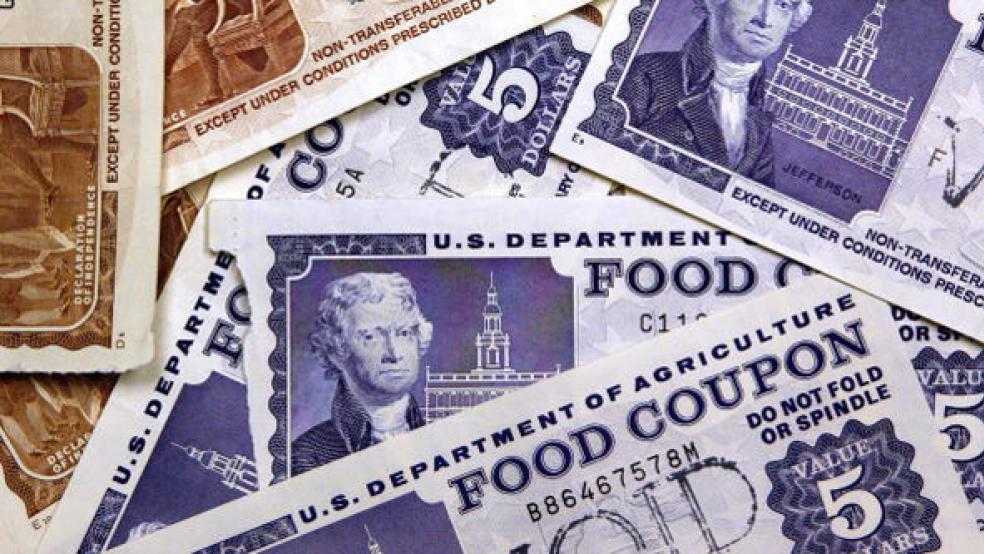Stung by election-year criticism of a program used by one in seven Americans, administrators of U.S. food stamp benefits are intensifying efforts to combat fraud and protect the $75.3 billion plan from the budget axe. Enrollment in the food aid program that helps the poor, elderly and disabled is running at record high levels, with 46.1 million people now participating.
High joblessness, persistent woes in the housing market and a tepid economic recovery have driven more that 14 million people to sign up for the benefits since U.S. President Barack Obama took office three years ago. That number includes many displaced workers, who are now attempting to eke out a living with low-wage or part-time jobs. In many states, a family of four with net income of just over $23,000 would qualify for food stamps.
The spike in enrollment prompted Republican presidential candidate Newt Gingrich to dub Obama the "food stamp president" and has fueled calls for cuts to assistance programs that critics say are turning the United States into a welfare state.
In the face of such criticism, officials responsible for food stamps are trumpeting the program's efficiency and vowing further improvements. Kevin Concannon, U.S. Department of Agriculture undersecretary for food, nutrition and consumer services, said his agency was doubling efforts to prevent fraud, which accounts for just 1 percent of food stamp benefits, but equals about $750 million each year. "This is $750 million that isn't being used to provide food to individuals and families and that issue isn't lost on us," Concannon said in a recent phone interview. "We want to maintain the confidence of American taxpayers because everyone is challenged in this economy, the payers as well as the folks who are benefiting from the program," he said.
The program's biggest step forward in fraud prevention came in 2004, when the government replaced paper coupons with plastic cards that are loaded electronically like debit cards. In 2008, the USDA changed the name of the program to the Supplemental Nutritional Assistance Program, or SNAP, but the benefits are still commonly referred to as food stamps. Concannon said the program was adding high-tech strategies to its enforcement quiver.
Those include working with social media firms and data mining company SRA International Inc to root out abuse. It also debuted a new website for public whistleblowers: www.fns.usda.gov/fightingsnapfraud. While administrators work to reduce payment errors, the USDA is collaborating with state agencies to investigate recipients suspected of committing fraud or misusing benefits. It also will seek tougher penalties for stores engaged in trafficking.
Trafficking generally takes the form of users "selling" their benefits for roughly 50 cents on the dollar to brick-and-mortar retailers or to individuals found via websites like eBay or Facebook. From October 1 through December 31, the USDA sanctioned more than 225 stores found to be violating program rules and permanently disqualified 350 stores for trafficking in SNAP benefits, a roughly 14 percent increase in disciplinary actions overall.
"Fraud is not a static concept. We know that where there is a will to commit malfeasance, bad actors will try to find a way," Concannon said.
ASSET TEST
Concannon and other supporters of the food stamp program are also warning against efforts by some states to toughen eligibility rules. The program is funded by the federal government but administered at the state level.
Programs in 36 states as well as the District of Columbia, Guam and the U.S. Virgin Islands have no asset test for food stamp eligibility. Such rules came under scrutiny last year, when it came to light that a Michigan man who won a $2 million lottery jackpot was collecting food stamps under a state loophole that counted only income, not assets. The man took his winnings in a lump sum, which categorized them as assets. Michigan has since closed the loophole and adopted an asset test.
Pennsylvania Governor Tom Corbett has proposed denying food stamps to households with assets of more than $5,500. The limit would be $9,000 for households that include a person who is disabled or age 60 or older. His original proposal, which had significantly lower asset limits, hit a wall of resistance from anti-hunger advocates, who called it unusually punitive.
Some U.S. lawmakers have called for asset tests for all recipients.
Concannon said the food stamp program was designed to help people weather tough times brought on by a job loss or illness. Requiring participants to exhaust their resources in order to qualify for benefits could leave them in a weakened position when the economy recovers, Concannon said. "We would caution states to be wary of just running down the road without thinking through the impact on their citizens, especially in what is still a tough jobs economy," he said.
(Additional reporting by Charles Abbott in Washington)




